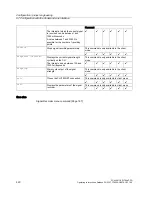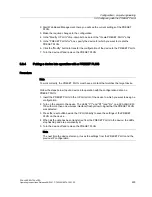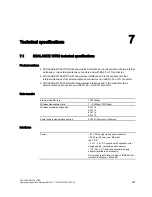
Appendix
A.2 Designing and calculating wireless systems (for example RCoax)
SCALANCE W786-xPRO
234
Operating Instructions, Release 08/2007, C79000-G8976-C221-02
A.2
Designing and calculating wireless systems (for example RCoax)
Decibels as a logarithmic unit of measure
In wireless technology, most calculations are made in decibels (dB). Decibel means the
logarithm of a ratio. Formulated mathematically, this can be shown by the following equation:
Decibel value = 10 * log (ratio)
Using sample calculations, the following decibel values are obtained:
Ratio
Decibel value
0,001 -30
dB
0,1 -10
dB
0,2 -7
dB
0,4 -4
dB
0,5 -3
dB
1 0
dB
2 3
dB
4 6
dB
As can be seen in the example, halving a value reduces the decibel value by 3 dB. This
remains true regardless of the selected reference variable because only the ratio counts.
Which reference variable is used can be recognized by the additional letters or numbers
following the dimension dB. In acoustics, for example, the threshold of audibility is the
reference variable for a value in dB(A).
Specifying power in dBm
A commonly used reference variable in wireless technology is a power of 1 mW. Power can
then be specified in the decibel milliwatt unit (dBm). The following formula is used:
P [dBm] = 10 * log (P [mW] / 1 mW)
This results in the following power specifications in dBm:
Power value
Decibel value
0.5 mW
≈
-3
dBm
1 mW
≈
0
dBm
2 mW
≈
3
dBm
4 mW
≈
6
dBm
10 mW
≈
10
dBm
100 mW
≈
20
dBm
200 mW
≈
23
dBm
1000 mW
≈
30
dBm






























